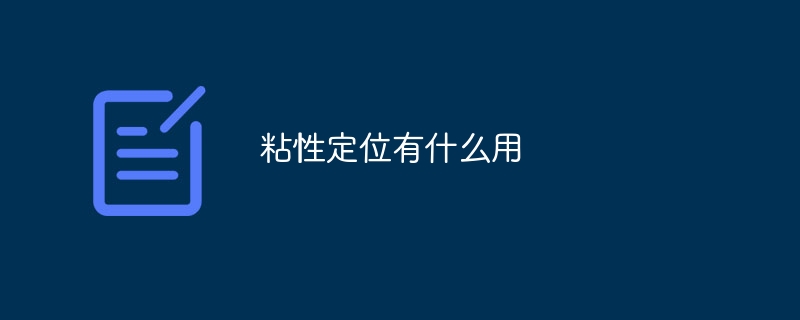Home >Web Front-end >Front-end Q&A >What is the use of sticky positioning?
What is the use of sticky positioning?
- 百草Original
- 2023-10-24 16:20:281593browse
Sticky positioning includes fixed navigation bar, fixed sidebar, fixed advertisement, floating prompt box, paging navigation, fixed header and visual effects, etc. Detailed introduction: 1. Fixed navigation bar. Sticky positioning can be used to create a fixed navigation bar. By setting the navigation bar to sticky positioning, the navigation bar can be kept at the top or bottom of the page and always visible when the page is scrolled; 2. Fixed sidebar and sticky positioning can create a fixed sidebar. By setting the sidebar to sticky positioning, you can keep the sidebar on one side of the page when the page is scrolled and not disappear as the page scrolls, etc.

The operating system for this tutorial: Windows 10 system, DELL G3 computer.
Sticky Positioning (Sticky Positioning) is a CSS property that allows elements to remain in a specific position on the page when scrolling. It has the following important uses in Web design and development:
1. Fixed navigation bar: Sticky positioning can be used to create a fixed navigation bar. By setting the navigation bar to sticky positioning, you can make the navigation bar remain visible at the top or bottom of the page as the page scrolls. In this way, users can easily access navigation functions when browsing pages, improving user experience.
2. Fixed sidebar: Sticky positioning can be used to create a fixed sidebar. By setting the sidebar to sticky positioning, you can keep the sidebar on one side of the page as the page scrolls, and not disappear as the page scrolls. This way, users can view the content of the sidebar at any time, such as relevant links, ads, or other important information.
3. Ad fixation: Sticky positioning can be used to fix the position of ads. By setting your ad to sticky positioning, you can keep your ad at a specific location on the page as the page scrolls, and not disappear as the page scrolls. In this way, advertisers can ensure that their ads are always visible, increasing their exposure and click-through rates.
4. Suspended prompt box: Sticky positioning can be used to create a suspended prompt box. By setting the tooltip to sticky positioning, you can keep the tooltip at a certain position on the page and always be visible when the page scrolls. In this way, when tips, guidance or important information need to be provided to the user, the prompt box can always be displayed to the user, thereby improving the user's operating efficiency and experience.
5. Paginated navigation: Sticky positioning can be used to create paginated navigation. By setting paging navigation to sticky positioning, you can keep the navigation bar at a specific position on the page when the page is scrolled and will not disappear as the page scrolls. In this way, users can easily switch between different pages or content, improving page navigability and user experience.
6. Header fixation: Sticky positioning can be used to fix the table header. By setting the table header to sticky positioning, you can keep the table header at the top of the page when the table content is scrolled and will not disappear as the table scrolls. In this way, users can always know the title of each column when viewing the table content, improving the readability and navigation of the table.
7. Visualization: Sticky positioning can be used to create a variety of attractive visualizations. By setting an element to sticky positioning, you can create dynamic effects on the element when the page is scrolled, such as the element appearing, disappearing, scaling or moving, etc. In this way, you can attract the user's attention and improve the attractiveness and interactivity of the page.
In summary, sticky positioning has a wide range of applications in Web design and development. It can be used to fix the position of navigation bars, sidebars, advertisements and prompt boxes to improve user experience and operational efficiency. At the same time, it can also be used for paging navigation, table header fixation and creation of visual effects to improve the readability, navigation and attractiveness of the page. By flexibly using sticky positioning, you can provide users with a better web browsing and interactive experience.
The above is the detailed content of What is the use of sticky positioning?. For more information, please follow other related articles on the PHP Chinese website!

